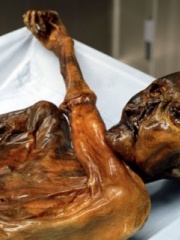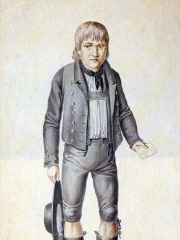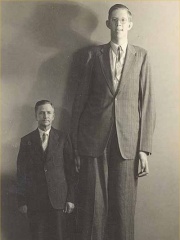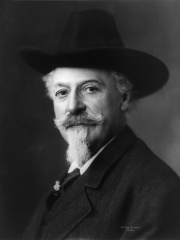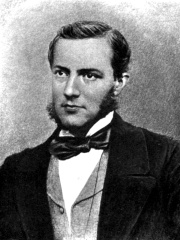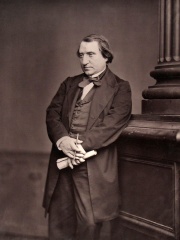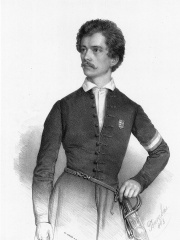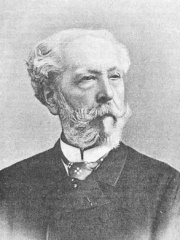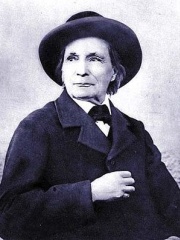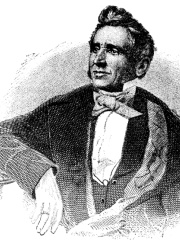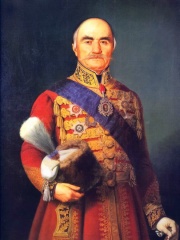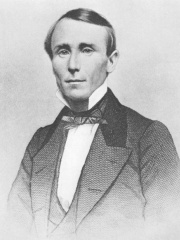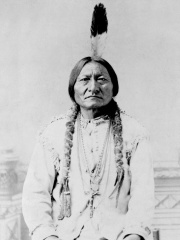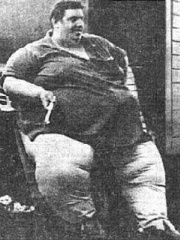CELEBRITY
Phineas Gage
1823 - 1860

 Phineas Gage
Phineas Gage
Phineas P. Gage (1823–1860) was an American railroad construction foreman remembered for his improbable[B1]: 19 survival of an accident in which a large iron rod was driven completely through his head, destroying much of his brain's left frontal lobe, and for that injury's reported effects on his personality and behavior over the remaining 12 years of his life—effects sufficiently profound that friends saw him (for a time at least) as "no longer Gage". Long known as the "American Crowbar Case"—once termed "the case which more than all others is calculated to excite our wonder, impair the value of prognosis, and even to subvert our physiological doctrines" —Phineas Gage influenced 19th-century discussion about the mind and brain, particularly debate on cerebral localization,[M]: ch7-9 [B] and was perhaps the first case to suggest the brain's role in determining personality, and that damage to specific parts of the brain might induce specific mental changes. Gage is a fixture in the curricula of neurology, psychology, and neuroscience,[M7]: 149 one of "the great medical curiosities of all time"[M8] and "a living part of the medical folklore" [R]: 637 frequently mentioned in books and scientific papers;[M]: ch14 he even has a minor place in popular culture. Read more on Wikipedia
Since 2007, the English Wikipedia page of Phineas Gage has received more than 7,269,312 page views. His biography is available in 38 different languages on Wikipedia (up from 35 in 2019). Phineas Gage is the 4th most popular celebrity (down from 3rd in 2019), the 124th most popular biography from United States (up from 146th in 2019) and the 2nd most popular American Celebrity.
Phineas Gage is most famous for being the first person to have a metal rod go through his brain. This accident happened when he was working as a railroad construction supervisor. The rod went through his left cheek and exited through the top of his head.
Memorability Metrics
7.3M
Page Views (PV)
74.06
Historical Popularity Index (HPI)
38
Languages Editions (L)
13.42
Effective Languages (L*)
1.69
Coefficient of Variation (CV)
Page views of Phineas Gages by language
Among CELEBRITIES
Among celebrities, Phineas Gage ranks 4 out of 181. Before him are Ötzi, Wallis Simpson, and Jeanne Calment. After him are Kaspar Hauser, Robert Wadlow, Simonetta Vespucci, Buffalo Bill, Lina Medina, Black Dahlia, Caitlyn Jenner, and Empress Michiko.
Most Popular Celebrities in Wikipedia
Go to all Rankings
Ötzi
3345 BC - 3255 BC
HPI: 79.83
Rank: 1
Wallis Simpson
1896 - 1986
HPI: 79.31
Rank: 2
Jeanne Calment
1875 - 1997
HPI: 74.46
Rank: 3
Phineas Gage
1823 - 1860
HPI: 74.06
Rank: 4
Kaspar Hauser
1812 - 1833
HPI: 71.01
Rank: 5
Robert Wadlow
1918 - 1940
HPI: 70.93
Rank: 6
Simonetta Vespucci
1453 - 1476
HPI: 69.17
Rank: 7
Buffalo Bill
1846 - 1917
HPI: 69.02
Rank: 8
Lina Medina
1933 - Present
HPI: 68.13
Rank: 9
Black Dahlia
1924 - 1947
HPI: 67.82
Rank: 10
Caitlyn Jenner
1949 - Present
HPI: 67.73
Rank: 11
Empress Michiko
1934 - Present
HPI: 67.31
Rank: 12

Contemporaries
Among people born in 1823, Phineas Gage ranks 2. Before him is Abdulmejid I. After him are Alfred Russel Wallace, Max Müller, Ernest Renan, Alexandre Cabanel, Gyula Andrássy, Leopold Kronecker, Sándor Petőfi, Édouard Lalo, Jean-Henri Fabre, and Li Hongzhang. Among people deceased in 1860, Phineas Gage ranks 2. Before him is Arthur Schopenhauer. After him are Désirée Clary, Jérôme Bonaparte, Alexandra Feodorovna, Charles Goodyear, János Bolyai, Miloš Obrenović, Stéphanie de Beauharnais, Princess Juliane of Saxe-Coburg-Saalfeld, William Walker, and István Széchenyi.
Others Born in 1823
Go to all Rankings
Abdulmejid I
1823 - 1861
HPI: 74.94
Rank: 1
Phineas Gage
1823 - 1860
HPI: 74.06
Rank: 2
Alfred Russel Wallace
1823 - 1913
HPI: 72.76
Rank: 3
Max Müller
1823 - 1900
HPI: 72.38
Rank: 4
Ernest Renan
1823 - 1892
HPI: 68.88
Rank: 5
Alexandre Cabanel
1823 - 1889
HPI: 68.06
Rank: 6
Gyula Andrássy
1823 - 1890
HPI: 67.95
Rank: 7
Leopold Kronecker
1823 - 1891
HPI: 65.87
Rank: 8
Sándor Petőfi
1823 - 1849
HPI: 65.43
Rank: 9
Édouard Lalo
1823 - 1892
HPI: 65.26
Rank: 10
Jean-Henri Fabre
1823 - 1915
HPI: 64.67
Rank: 11
Li Hongzhang
1823 - 1901
HPI: 63.33
Rank: 12

Others Deceased in 1860
Go to all Rankings
Arthur Schopenhauer
1788 - 1860
HPI: 84.74
Rank: 1
Phineas Gage
1823 - 1860
HPI: 74.06
Rank: 2
Désirée Clary
1777 - 1860
HPI: 71.43
Rank: 3
Jérôme Bonaparte
1784 - 1860
HPI: 69.23
Rank: 4
Alexandra Feodorovna
1798 - 1860
HPI: 69.10
Rank: 5
Charles Goodyear
1800 - 1860
HPI: 68.17
Rank: 6
János Bolyai
1802 - 1860
HPI: 65.30
Rank: 7
Miloš Obrenović
1780 - 1860
HPI: 64.98
Rank: 8
Stéphanie de Beauharnais
1789 - 1860
HPI: 62.50
Rank: 9
Princess Juliane of Saxe-Coburg-Saalfeld
1781 - 1860
HPI: 60.74
Rank: 10
William Walker
1824 - 1860
HPI: 59.00
Rank: 11
István Széchenyi
1791 - 1860
HPI: 58.92
Rank: 12

In United States
Among people born in United States, Phineas Gage ranks 124 out of 18,182. Before him are Madonna (1958), Vince McMahon (1945), James Watson (1928), Ray Charles (1930), Sitting Bull (1831), and Brad Pitt (1963). After him are Isadora Duncan (1877), Grace Hopper (1906), Linus Pauling (1901), Clark Gable (1901), Dr. Seuss (1904), and Sharon Tate (1943).
Others born in United States
Go to all Rankings
Madonna
1958 - Present
HPI: 74.41
Rank: 118
Vince McMahon
1945 - Present
HPI: 74.11
Rank: 119
James Watson
1928 - Present
HPI: 74.10
Rank: 120
Ray Charles
1930 - 2004
HPI: 74.10
Rank: 121
Sitting Bull
1831 - 1890
HPI: 74.08
Rank: 122
Brad Pitt
1963 - Present
HPI: 74.06
Rank: 123
Phineas Gage
1823 - 1860
HPI: 74.06
Rank: 124
Isadora Duncan
1877 - 1927
HPI: 74.00
Rank: 125
Grace Hopper
1906 - 1992
HPI: 73.92
Rank: 126
Linus Pauling
1901 - 1994
HPI: 73.87
Rank: 127
Clark Gable
1901 - 1960
HPI: 73.86
Rank: 128
Dr. Seuss
1904 - 1991
HPI: 73.86
Rank: 129
Sharon Tate
1943 - 1969
HPI: 73.86
Rank: 130

Among CELEBRITIES In United States
Among celebrities born in United States, Phineas Gage ranks 2. Before him are Wallis Simpson (1896). After him are Robert Wadlow (1918), Buffalo Bill (1846), Black Dahlia (1924), Caitlyn Jenner (1949), Jon Brower Minnoch (1941), Monica Lewinsky (1973), Margaret Brown (1867), Sarah Knauss (1880), Peggy Guggenheim (1898), and Don King (1931).

Wallis Simpson
1896 - 1986
HPI: 79.31
Rank: 1
Phineas Gage
1823 - 1860
HPI: 74.06
Rank: 2
Robert Wadlow
1918 - 1940
HPI: 70.93
Rank: 3
Buffalo Bill
1846 - 1917
HPI: 69.02
Rank: 4
Black Dahlia
1924 - 1947
HPI: 67.82
Rank: 5
Caitlyn Jenner
1949 - Present
HPI: 67.73
Rank: 6
Jon Brower Minnoch
1941 - 1983
HPI: 66.99
Rank: 7
Monica Lewinsky
1973 - Present
HPI: 64.57
Rank: 8
Margaret Brown
1867 - 1932
HPI: 63.44
Rank: 9
Sarah Knauss
1880 - 1999
HPI: 62.60
Rank: 10
Peggy Guggenheim
1898 - 1979
HPI: 62.34
Rank: 11
Don King
1931 - Present
HPI: 61.12
Rank: 12

